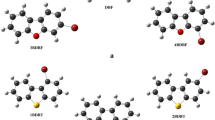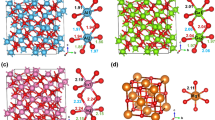Abstract
The ability of C6F5X (X = Cl, Br, I) to favorably interact with ZH3 (Z = N, P, As) was evaluated at the level of M06-2X functional. For comparison, the C6F5I···ZPh3 (Z = N, P, As) complex was also studied. The halogen bond donors C6F5X (X = Cl, Br, I) have positive regions of electrostatic potentials (ESP) outside the X atom, and could interact with the negative ESP outside the Z atom of ZH3 (Z = N, P, As) to form the X···Z halogen bond. When the halogen bond donor remains unchanged, the halogen bond strength grows along the decreasing size of As, P, and N. When halogen bond acceptor remains unchanged, the halogen bond becomes stronger gradually along the sequence of X = Cl, Br, I. It was found that C6F5I···ZPh3 complex greatly reduces the strength of the halogen bond comparing with the C6F5I···ZH3.




Similar content being viewed by others
References
Evans NH, Beer PD (2014) Advances in anion supramolecular chemistry: from recognition to chemical applications. Angew Chem Int Ed Engl 53:11716–11754
Bauzá A, Frontera A (2015) Aerogen bonding interaction: a new supramolecular force? Angew Chem Int Ed Engl 54:7340–7343
Hobza P, Řezáč J (2016) Introduction: noncovalent interactions. Chem Rev 116:4911–4912
Han Z, Czap G, Chiang C, Xu C, Wagner PJ, Wei X, Zhang Y, Wu R, Ho W (2017) Imaging the halogen bond in self-assembled halogenbenzenes on silver. Sci 358:206–210
Gilday LC, Robinson SW, Barendt TA, Langton MJ, Mullaney BR, Beer PD (2015) Halogen bonding in supramolecular chemistry. Chem Rev 115:7118–7195
Hunter CA, Misuraca MC, Turega SM (2011) Influence of H-bond strength on chelate cooperativity. J Am Chem Soc 133:20416–20425
Lindblad S, Mehmeti K, Veiga AX, Nekoueishahraki B, Gräfenstein J, Erdélyi M (2018) Halogen bond asymmetry in solution. J Am Chem Soc 140:13503–13513
Clark T, Murray JS, Politzer P (2018) A perspective on quantum mechanics and chemical concepts in describing noncovalent interactions. Phys Chem Chem Phys 20:30076–30082
Erdelyi M (2014) Scientific conferences: a big hello to halogen bonding. Nat Chem 6:762–764
KoláŘ MH, Hobza P (2016) Computer modeling of halogen bonds and other sigma-hole interactions. Chem Rev 116:5155–5187
Cavallo G, Metrangolo P, Milani R, Pilati T, Priimagi A, Resnati G, Terraneo G (2016) The halogen bond. Chem Rev 116:2478–2601
Metrangolo P, Meyer F, Pilati T, Resnati G, Terraneo G (2008) Halogen bonding in supramolecular chemistry. Angew Chem Int Ed Engl 47:6114–6127
Wang H, Wang W, Jin WJ (2016) Sigma-hole bond vs pi-hole bond: a comparison based on halogen bond. Chem Rev 116:5072–5104
Lisac K, Topić F, Arhangelskis M, Cepić S, Julien PA, Nickels CW, Morris AJ, Friščić T, Cinčić D (2019) Halogen-bonded cocrystallization with phosphorus, arsenic and antimony acceptors. Nat Commun 10:61
Xu Y, Huang J, Gabidullin B, Bryce DL (2018) A rare example of a phosphine as a halogen bond acceptor. Chem Commun 54:11041–11043
Riley KE, Murray JS, Fanfrlík J, Řezáč J, Solá RJ, Concha MC, Ramos FM, Politzer P (2011) Halogen bond tunability I: the effects of aromatic fluorine substitution on the strengths of halogen-bonding interactions involving chlorine, bromine, and iodine. J Mol Model 17:3309–3318
Zhao Y, Truhlar DG (2007) The M06 suite of density functionals for main group thermochemistry, thermochemical kinetics, noncovalent interactions, excited states, and transition elements: two new functionals and systematic testing of four M06-class functionals and 12 other functionals. Theor Chem Accounts 120:215–241
Hay PJ (1977) Gaussian basis sets for molecular calculations. The representation of 3d orbitals in transition-metal atoms. J Chem Phys 66:4377–4384
Krishnan R, Binkley JS, Seeger R, Pople JA (1980) Self-consistent molecular orbital methods. XX A basis set for correlated wave functions. J Chem Phys 72:650–654
McLean AD, Chandler GS (1980) Contracted Gaussian basis sets for molecular calculations. I. Second row atoms, Z=11–18. J Chem Phys 72:5639–5648
Wachters AJH (1970) Gaussian basis set for molecular wavefunctions containing third-row atoms. J Chem Phys 52:1033–1036
Frisch MJ, Trucks GW, Schlegel HB, Scuseria GE, Robb MA, Cheeseman JR, Scalmani G, Barone V, Mennucci B, Petersson GA, Nakatsuji H, Caricato M, Li X, Hratchian HP, Izmaylov AF, Bloino J, Zheng G, Sonnenberg JL, Hada M, Ehara M, Toyota K, Fukuda R, Hasegawa J, Ishida M, Nakajima T, Honda Y, Kitao O, Nakai H, Vreven T, Montgomery Jr JA, Peralta JE, Ogliaro F, Bearpark M, Heyd JJ, Brothers E, Kudin KN, Staroverov VN, Keith T, Kobayashi R, Normand J, Raghavachari K, Rendell A, Burant JC, Iyengar SS, Tomasi J, Cossi M, Rega N, Millam JM, Klene M, Knox JE, Cross JB, Bakken V, Adamo C, Jaramillo J, Gomperts R, Stratmann RE, Yazyev O, Austin AJ, Cammi R, Pomelli C, Ochterski JW, Martin RL, Morokuma K, Zakrzewski VG,VothGA, Salvador P, Dannenberg JJ, Dapprich S, DanielsAD, Farkas O, Foresman JB, Ortiz JV, Cioslowski J, Fox DJ (2009) Gaussian 09, Revision A.02. Gaussian, Inc, Wallingford, CT
Boys SF, Bernardi F (2006) The calculation of small molecular interactions by the differences of separate total energies. Some procedures with reduced errors. Mol Phys 19:553–566
Clark T, Politzer P, Murray JS (2015) Correct electrostatic treatment of noncovalent interactions: the importance of polarization. Comput Mol Sci 5:169–177
Glendening ED, Landis CR, Weinhold F (2013) NBO 6.0: natural bond orbital analysis program. J Comput Chem 34:1429–1437
Zheng SJ, Hada M, Nakatsuji H (1996) Topology of density difference and force analysis. Theor Chim Acta 93:67–78
Lu T, Chen F (2012) Multiwfn: a multifunctional wavefunction analyzer. J Comput Chem 33:580–592
Keith TA (2015) AIMAll (Version 15.09.27)
Bulat FA, Toro-Labbé A, Brinck T, Murray JS, Politzer P (2010) Quantitative analysis of molecular surfaces: areas, volumes, electrostatic potentials and average local ionization energies. J Mol Model 16:1679–1691
Murray JS, Paulsen K, Politzer P (1994) Molecular surface electrostatic potentials in the analysis of non-hydrogen-bonding noncovalent interactions. Proc Indian Acad Sci (Chem Sci) 106:267–275
Bader RFW (1985) Atoms in molecules. Acc Chem Res 18:9–15
Liu M, Zeng Y, Sun Z, Meng L (2019) Predicting the halogen-n (n = 3-6) synthons to form the “windmill” pattern bonding based on the halogen-bonded interactions. J Comput Chem 40:1219–1226
Zhou F, Liu Y, Wang Z, Lu T, Yang Q, Liu Y, Zheng B (2019) A new type of halogen bond involving multivalent astatine: an ab initio study. Phys Chem Chem Phys 21:15310–15318
Yan N, Huo S, Li X, Zeng Y, Meng L (2019) The chalcogen bond in F2P(S)NSX2, F2PNSSX2, F2PSNSX2 (X = F, Cl, Br, OH, CH3, NH2) complexes. J Mol Model 25:19
Li W, Zeng Y, Zhang X, Zheng S, Meng L (2014) The enhancing effects of group V σ-hole interactions on the F⋯ O halogen bond. Phys Chem Chem Phys 16:19282–19289
Politzer P, Riley KE, Bulat FA, Murray JS (2012) Perspectives on halogen bonding and other σ-hole interactions: Lex parsimoniae (Occam’s Razor). Comput Theor Chem 998:2–8
Funding
This work was supported by the Natural Science Foundation of Hebei Province (Contract No.: B2019205113, B2019205023), the National Natural Science Foundation of China (Contract No. 21973025, 21903020), the top 100 innovative talents program in higher institutions of Hebei Province (SLRC2017041), and the Foundation of Hebei Normal University (L2020Z04).
Author information
Authors and Affiliations
Corresponding author
Ethics declarations
Competing interests
The authors declare that they have no competing interests.
Additional information
Publisher’s note
Springer Nature remains neutral with regard to jurisdictional claims in published maps and institutional affiliations.
Rights and permissions
About this article
Cite this article
Ping, N., Zhang, H., Meng, L. et al. Insight into the halogen-bonding interactions in the C6F5X···ZH3 (X = Cl, Br, I; Z = N, P, As) and C6F5I···Z (Ph)3 (Z = N, P, As) complexes. Struct Chem 32, 767–774 (2021). https://doi.org/10.1007/s11224-020-01656-z
Received:
Accepted:
Published:
Issue Date:
DOI: https://doi.org/10.1007/s11224-020-01656-z




